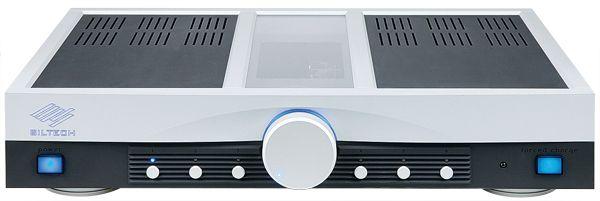Siltech Saga C1, V1 And P1 (£85,000)

The C1 line preamp is a ‘minimalist’ zero-feedback design that employs four selected ECC86 valves, one pair as current source and the other set as the anode follower. The C1’s audio signal path is point-to-point wired with silver monocrystal cables (in the P1 too) and has been kept separate from the logic control circuitry that governs battery charging, input switching and volume control.
A plug-top power supply and lead connects to the rear of the C1, the back panel also housing the unit’s main on/off rocker switch plus XLR and RCA analogue outputs.
As in the preamplifier, the V1 voltage amp runs off its 24V safety type lead ‘gel’ battery supply, and as with the C1 has illuminated standby and ‘forced charging’ buttons left and right respectively.
The V1 is a ‘zero feedback’ design with two independent tube circuits that may be selected according to taste. The toggle switch between pentode and (lower gain) triode modes is hidden on the bottom plate of the V1, to avoid inadvertent switching from causing accidental damage to speakers. The P1 current stage amplifier is also a ‘zero negative feedback’ design and features an innovative ‘Apollo Lightdrive’ switchmode PSU that’s optically decoupled from the super emitter-follower output stage.
Which mode?
The SAGA was auditioned through the editor’s B&W Nautilus 802 floorstanders and with balanced connections used throughout. A variety of music, either ripped from CD or native hi-res 24-bit files at various sampling rates up to 192kHz, were played via a Cambridge Audio BD player [see p37]. The digital output of the player fed T+A’s DAC 8, yet we were surprised to hear little or no difference between the Cambridge player and the standalone DAC when A/B’d in quick succession.
The sound was notably ‘clean’ and free of treble grain, producing stable images between and beyond the speakers of high-end calibre whether listening to the analogue output of the Cambridge player or the output of the exceptionally fine DAC 8. This might imply that the SAGA amplifier is unusually ‘source agnostic’, sounding exquisite whatever component is upstream.
Further listening in our test system showed that the SAGA is not without its own character, albeit producing a tightly-focused and notably smooth and comfortable sound. Female vocals in particular benefited from the SAGA’s uncommon civility and desiccated midband clarity. Anita Baker’s ‘Sweet Love’ from Rapture [24-bit/192kHz download from HDtracks] had great energy and dynamic punch, the recording’s artificially splashy cymbals and multi-layered keyboards now kept nicely in check.
In the test system Eleanor McEvoy’s If You Leave [Moscodisc] recording sounded better with the SAGA operating in pentode mode. Conversely, when listening to the fabulous 24-bit/176.4kHz Exotic Dances From The Opera [Reference Recordings] the dynamic performance was seemingly allowed much more free rein when the SAGA was switched to triode operation.
Verdict
Intriguing and unique in its design concept, this is the sort of product that makes audio such an utterly fascinating hobby, proving there’s so much more to be discovered. The SAGA’s calm, unfussy sound quality is sure to win the ears and hearts of the well-heeled music lover.
Originally published in the 2013 Yearbook























































